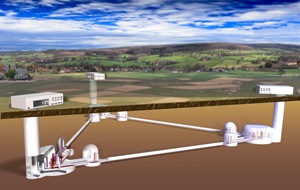European scientists have presented the design study of the sophisticated third-generation gravitational wave (GW) detector called the Einstein Observatory (ET) at the European Gravitational Observatory located in Pisa, Italy.
The Einstein Observatory, which will have a sensitivity 100 times higher than existing devices, can observe minuscule changes in space-time and can accurately measure gravitational waves. It can also analyze cosmic catastrophes, including supernovae, collapsing stars and merging black holes, and like Big Bang, it can analyze the early stages of the universe.
 Artistic view of the ET observatory
Artistic view of the ET observatory
The Einstein Observatory (ET), similar to its predecessors, is based on the metering of small alterations at a size comparatively very smaller than atomic nucleus across the lengths of two multiple kilometer-long linked arms, created by a transitory gravity wave. Laser transmitting through the arms capture their periodic shrinking and stretching as interference designs in a central photodetector. The first two generations are not having the sensitivity to analyze the GW sources accurately.
At the presentation, the ET’s technology, layout, scientific targets, expected expenditures and timescale were highlighted. In order to decrease the residual seismic motion impact and attain I A superb sensitivity, the ET will be constructed 100 to 200 m below the earth surface. This makes the ET ultra sensitive at a low frequency range from 1 to 100 Hz. Thus, the ET can measure all of the GW frequencies from 1 Hz to 10 kHz on the earth. According to the design study’s scientific coordinator, Michele Punturo, an observatory having that much ultra sensitivity will make the detection of GWa day-to-day astronomical instrument, resulting in a scientific upheaval.
The main objective of the design study is to offer GW information to support the analysis of telescope observing electromagnetic radiation, ranging between radio waves and gamma rays, and other tools analyzing space about high-energy particles. The deputy scientific coordinator of the ET Design Study, Harald Lück, commented that over 200 researchers from Europe and throughout the globe had spent three years to develop the design study of ET.
The ET project will construct an observatory with three nested GW detectors to tackle the problems of existing detector sites. Every detector comprises two interferometers with 10-km long arms. One interferometer will determine components with high frequency, while the next one will determine gravitational wave signals having low frequency range between 2 and 40 Hz. The design of the observatory will accommodate further developments and upgrading of components in interferometry. The European Commission has granted €3 million under its Seventh Framework Program (FP7-Capacities) for the design study.